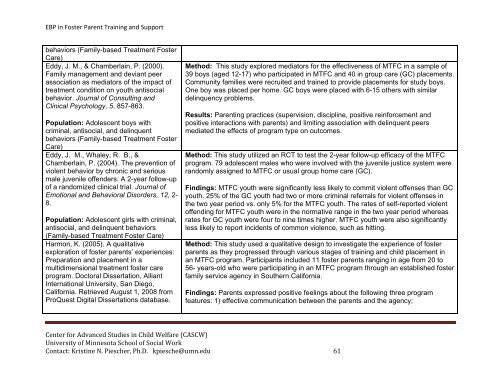Evidence-Based Practice in Foster Parent Training and Support ...
Evidence-Based Practice in Foster Parent Training and Support ...
Evidence-Based Practice in Foster Parent Training and Support ...
Create successful ePaper yourself
Turn your PDF publications into a flip-book with our unique Google optimized e-Paper software.
EBP <strong>in</strong> <strong>Foster</strong> <strong>Parent</strong> Tra<strong>in</strong><strong>in</strong>g <strong>and</strong> <strong>Support</strong>behaviors (Family-based Treatment <strong>Foster</strong>Care)Eddy, J. M., & Chamberla<strong>in</strong>, P. (2000).Family management <strong>and</strong> deviant peerassociation as mediators of the impact oftreatment condition on youth antisocialbehavior. Journal of Consult<strong>in</strong>g <strong>and</strong>Cl<strong>in</strong>ical Psychology, 5, 857-863.Population: Adolescent boys withcrim<strong>in</strong>al, antisocial, <strong>and</strong> del<strong>in</strong>quentbehaviors (Family-based Treatment <strong>Foster</strong>Care)Eddy, J. M., Whaley, R. B., &Chamberla<strong>in</strong>, P. (2004). The prevention ofviolent behavior by chronic <strong>and</strong> seriousmale juvenile offenders: A 2-year follow-upof a r<strong>and</strong>omized cl<strong>in</strong>ical trial. Journal ofEmotional <strong>and</strong> Behavioral Disorders, 12, 2-8.Population: Adolescent girls with crim<strong>in</strong>al,antisocial, <strong>and</strong> del<strong>in</strong>quent behaviors(Family-based Treatment <strong>Foster</strong> Care)Harmon, K. (2005). A qualitativeexploration of foster parents’ experiences:Preparation <strong>and</strong> placement <strong>in</strong> amultidimensional treatment foster careprogram. Doctoral Dissertation, AlliantInternational University, San Diego,California. Retrieved August 1, 2008 fromProQuest Digital Dissertations database.Method: This study explored mediators for the effectiveness of MTFC <strong>in</strong> a sample of39 boys (aged 12-17) who participated <strong>in</strong> MTFC <strong>and</strong> 40 <strong>in</strong> group care (GC) placements.Community families were recruited <strong>and</strong> tra<strong>in</strong>ed to provide placements for study boys.One boy was placed per home. GC boys were placed with 6-15 others with similardel<strong>in</strong>quency problems.Results: <strong>Parent</strong><strong>in</strong>g practices (supervision, discipl<strong>in</strong>e, positive re<strong>in</strong>forcement <strong>and</strong>positive <strong>in</strong>teractions with parents) <strong>and</strong> limit<strong>in</strong>g association with del<strong>in</strong>quent peersmediated the effects of program type on outcomes.Method: This study utilized an RCT to test the 2-year follow-up efficacy of the MTFCprogram. 79 adolescent males who were <strong>in</strong>volved with the juvenile justice system werer<strong>and</strong>omly assigned to MTFC or usual group home care (GC).F<strong>in</strong>d<strong>in</strong>gs: MTFC youth were significantly less likely to commit violent offenses than GCyouth. 25% of the GC youth had two or more crim<strong>in</strong>al referrals for violent offenses <strong>in</strong>the two year period vs. only 5% for the MTFC youth. The rates of self-reported violentoffend<strong>in</strong>g for MTFC youth were <strong>in</strong> the normative range <strong>in</strong> the two year period whereasrates for GC youth were four to n<strong>in</strong>e times higher. MTFC youth were also significantlyless likely to report <strong>in</strong>cidents of common violence, such as hitt<strong>in</strong>g.Method: This study used a qualitative design to <strong>in</strong>vestigate the experience of fosterparents as they progressed through various stages of tra<strong>in</strong><strong>in</strong>g <strong>and</strong> child placement <strong>in</strong>an MTFC program. Participants <strong>in</strong>cluded 11 foster parents rang<strong>in</strong>g <strong>in</strong> age from 20 to56- years-old who were participat<strong>in</strong>g <strong>in</strong> an MTFC program through an established fosterfamily service agency <strong>in</strong> Southern California.F<strong>in</strong>d<strong>in</strong>gs: <strong>Parent</strong>s expressed positive feel<strong>in</strong>gs about the follow<strong>in</strong>g three programfeatures: 1) effective communication between the parents <strong>and</strong> the agency;Center for Advanced Studies <strong>in</strong> Child Welfare (CASCW)University of M<strong>in</strong>nesota School of Social WorkContact: Krist<strong>in</strong>e N. Piescher, Ph.D. kpiesche@umn.edu 61
















